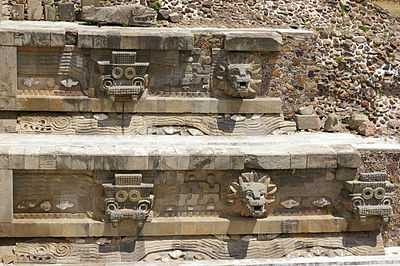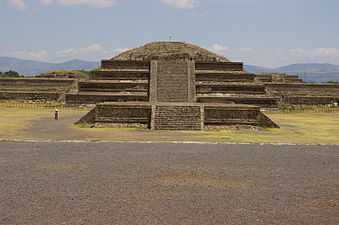Temple of the Feathered Serpent, Teotihuacan

The Temple of the Feathered Serpent is the modern-day name for the third largest pyramid at Teotihuacan, a pre-Columbian site in central Mexico. This structure is notable partly due to the discovery in the 1980s of more than a hundred possibly-sacrificial victims found buried beneath the structure.[1] The burials, like the structure, are dated to some time between 150 and 200 CE.[2] The pyramid takes its name from representations of the Mesoamerican "feathered serpent" deity which covered its sides. These are some of the earliest-known representations of the feathered serpent, often identified with the much-later Aztec god Quetzalcoatl.[3] The structure is also known as the Temple of Quetzalcoatl, and the Feathered Serpent Pyramid.
Location
The Temple of the Feathered Serpent is located at the southern end of the Avenue of the Dead, Teotihuacan's main thoroughfare, within the Ciudadela complex. The Ciudadela (Spanish, "citadel") is a structure with high walls and a large courtyard surrounding the temple. The Ciudadela’s courtyard is massive enough that it could house the entire adult population of Teotihuacán within its walls, which was estimated to be one hundred thousand people at its peak. Within the Ciudadela there are several monumental structures, including the temple, two mansions north and south of the temple, and the Adosada platform. Built in the 4th century, the Adosada platform is located just in front (west) of the Temple of the Feathered Serpent, obscuring its view.

Architecture
The Feathered Serpent Pyramid is a six-level step pyramid built in the talud-tablero style. The outside edges of each level are decorated with feathered serpent heads alternating with those of another snake-like creature, often identified as Tlaloc. Nevertheless, Mary Ellen Miller and Karl Taube claim that these heads may represent a "war serpent",[4] while Michael D. Coe claims, somewhat similarly, that they probably represent the "fire serpent" wearing a headdress with the Teotihuacan symbol for war.[5] In the eyes of these figures there is a spot for obsidian glass to be put in, so when the light hits, its eyes would glimmer. In antiquity the entire pyramid was painted – the background here was blue with carved sea shells providing decoration.[6] Under each row of heads are bas-reliefs of the full feathered serpent, in profile, also associated with water symbols. These and other designs and architectural elements are more than merely decorative, suggesting "strong ideological significance", although there is no consensus just what that significance is. Some interpret the pyramid's iconography as cosmological in scope – a myth of the origin of time or of creation – or as calendrical in nature. Others find symbols of rulership, or war and the military.[7]
Today the pyramid is largely hidden by the Adosada platform hinting at political restructurisation of Teotihuacan during the fourth century CE, perhaps a "rejection of autocratic rule" in favour of a collective leadership.[8] Following excavations in the early 20th century, a section of a façade on the monument's west side was discovered. This section is believed to date from the late 3rd century. Fantastic and rare carvings on the surfaces show depictions of the feathered serpent deity, other gods, and seashells on panels on either side of a staircase.
Condition and conservation
Since the structure has been exposed to the elements for the entire duration of its history, rain and groundwater, crystallization of soluble salts on the surface, erosion, and biological growth have caused deterioration and loss of stone on the surface. Tourist visitation also accelerated the deterioration. In 2004, the Temple of Quetzalcoatl was listed in the 2004 World Monuments Watch by the World Monuments Fund. The organization provided assistance for conservation in cooperation with the Instituto Nacional de Antropología e Historia and with help from American Express[9]

Burials at the pyramid
Two hundred or more, sacrificial burials were found at the pyramid, believed to be carried out as part of the dedication of the temple.[10] The burials are grouped in various locations, the significance of which is not yet understood. While there are burials of both men and women, the males outnumber the females. The males were accompanied by the remains of weapons and accoutrements, such as necklaces of human teeth, that lead researchers to conclude that they were warriors, probably warriors in service to Teotihuacan rather than captives from opposing armies. The richness of the burial goods generally increases toward the center of the pyramid. At least three degrees of status have been identified, although there is no indication of a dead ruler or other obvious focal point.[11]
Recent discoveries
On Thursday, May 26, 2011, Researchers from Mexico's National University reported that a tunnel structure had been found beneath the Temple of the Feathered Serpent using a radar device. Archaeologists there claim they have found what appears to be a series of symbols along the tunnel, 15 meters beneath the ground and 130 meters long, running eastwards and terminating in several sealed funeral chambers beneath the pyramid. The significance or orientation of the symbols is not yet understood, though it is thought they might be connected to imagery of the Mesoamerican underworld. Excavations are ongoing, and researchers are hopeful that orientation of the tunnel and position of the chambers indicate that they may contain the remains of early rulers or other high status individuals at Teotihuacan. Researchers reported that the tunnel was believed to have been sealed in 200 CE.[12][13]
In November, 2014 "large quantities" of mercury were discovered in a chamber 60 feet below the 1800 year old "Pyramid of the Feathered Serpent, the third largest pyramid of Teotihuacan," Mexico along with "jade statues, jaguar remains, a box filled with carved shells and rubber balls."[14]
Relation to the calendar
There was an apparent correlation between the Temple of the Feathered Serpent and the calendar. The pyramid also is thought to contain two hundred and sixty feathered serpent heads between the platforms. Each of these feathered serpents also contains an open area in its mouth. This open area is big enough to put a place holder in. Thus, it is believed that the people of Teotihuacán would move this place marker around the pyramid to represent the ritual calendar. When a spiritual day would arrive the people would gather within the walls of the Ciudadela and celebrate the ritual.
Political influences
The Temple of the Feathered Serpent was not only a religious center but also a political center as well. The rulers of Teotihuacán were not only the leaders of men; they were also the spiritual leaders of the city. The two mansions near the pyramid are thought to have been occupied by powerful families. An interesting feature of the Feathered Serpent Pyramid is that there are examples of a shift in power or ideology in Teotihuacán and for the Pyramid itself. The construction of the Adosada platform came much later than the Feathered Serpent Pyramid. The Adosada platform is built directly in front of the pyramid and blocks its front view. Thus, it is thought that the political leaders lost favor or that the ideology of the Feathered Serpent Pyramid lost virtue, and so was covered up by the Adosada.
Gallery
-

Adosada platform in the midground, Pyramid of the Feathered Serpent behind the platform, person beside a small platform in the foreground gives scale
-

Pyramid of the Feathered Serpent and the Adosada platform
-

Pyramid of the Feathered Serpent and the Adosada platform
-

View of the Pyramid architectural detail to the left of the steps
Notes
- ↑ "In the 1980s several mass graves were discovered under the temple. In all, 137 bodies were discovered, and it seems that the people were probably sacrificed when the temple was built, since their hands were tied behind their backs..."
- ↑ Castro.
- ↑ Miller and Taube (1993), p.162.
- ↑ Miller & Taube p. 162
- ↑ Coe, p. 98.
- ↑ Coe, p. 98.
- ↑ A summary of the possible iconographic interpretation can be found in Spence et al., p. 1.
- ↑ Cowgill (2003), p. 211-212.
- ↑ World Monuments Fund - Teotihuacan Archaeological Site - Quetzalcoatl Temple
- ↑ Cowgill (2002).
- ↑ Cowgill (2003), p. 210-211.
- ↑ Vancouver Sun May 26th 2011 "Ancient Tunnel Could Lead to Rulers' Tombs"
- ↑ physorg.com
- ↑
References
- Castro, Ruben Cabrera (1993) "Human Sacrifice at the Temple of the Feathered Serpent: Recent Discoveries at Teotihuacan" Kathleen Berrin, Esther Pasztory, eds., Teotihuacan, Art from the City of the Gods, Thames and Hudson, Fine Arts Museums of San Francisco, ISBN 0-500-27767-2.
- Coe, Michael D.; Rex Koontz (2002). Mexico: from the Olmecs to the Aztecs (5th edition, revised and enlarged ed.). London and New York: Thames & Hudson. ISBN 0-500-28346-X. OCLC 50131575.
- Cowgill, George L. (2002) "Ritual Sacrifice and the Feathered Serpent Pyramid at Teotihuacán, México", Foundation for the Advancement of Mesoamerican Studies, Inc., accessed September 2008.
- Cowgill, George L. (2003) "Social Differentiation at Teotihuacan" in Mesoamerican Elites: An Archaeological Assessment, Diane Z. Chase, Arlen F. Chase, eds., University of Oklahoma Press, ISBN 978-0-8061-3542-7.
- Hendon, Julia A.; Joyce, Rosemary A. (Eds.) (2003). Mesoamerican Archaeology: Theory and Practice. Blackwell Publishing. ISBN 0-631-23051-3.
- Miller, Mary Ellen; Karl Taube (1993). The Gods and Symbols of Ancient Mexico and the Maya. London: Thames and Hudson. ISBN 0-500-05068-6.
- Spence, Michael W.; Christine D. White, Fred J. Longstaffe, and Kimberley R. Law (2004) "Victims of the Victims, Human trophies worn by sacrificed soldiers from the Feathered Serpent Pyramid, Teotihuacan", Ancient Mesoamerica, vol. 5, pp. 1–15.